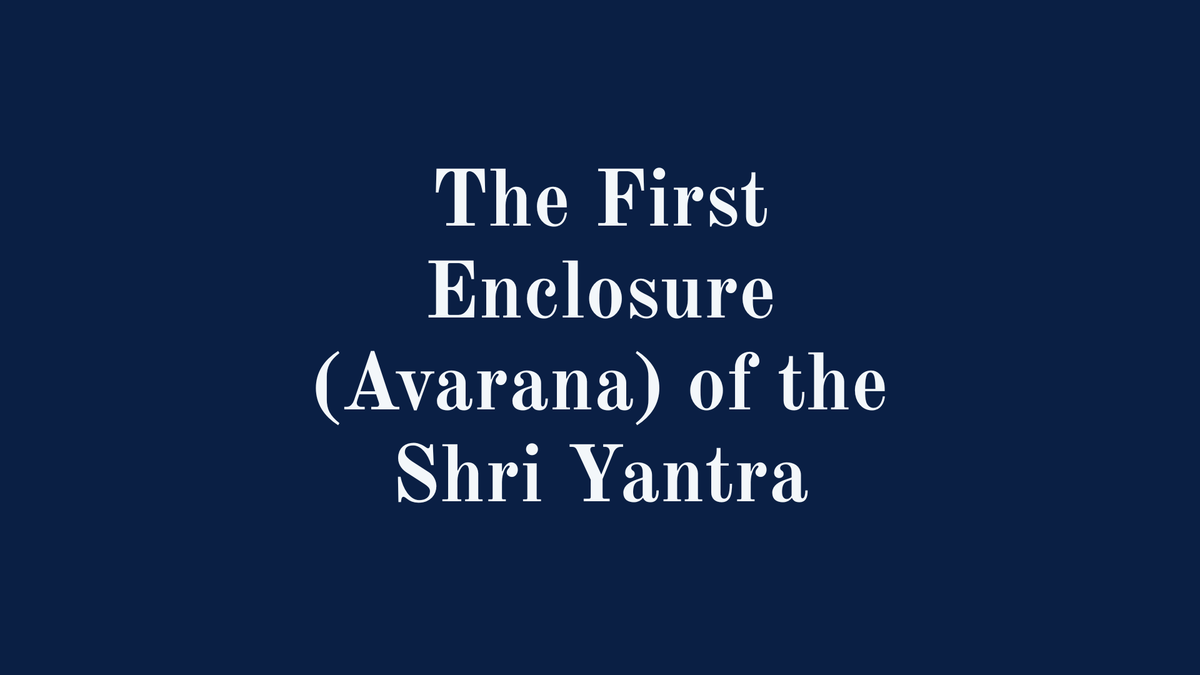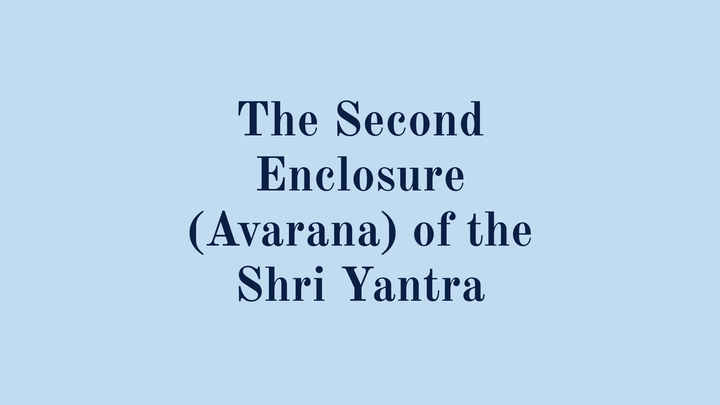The First Enclosure (Avarana) of the Shri Yantra

The first and outermost enclosure of the Śrī Cakra is called Trailokya Mohana Cakra. Also known as Bhū-pura or Caturaśra, this layer forms the sacred outer square that encircles the entire maṇḍala. It is referred to as the "Deluder of the Three Realms," as it shields the aspirant from distractions arising from the physical, astral, and causal worlds.
This āvaraṇa symbolizes the realm of the body, mind, and desires—where the journey begins. It guards the entrance into the sacred geometry of the Śrī Cakra and serves to purify, prepare, and align the aspirant’s inner energies.
🔲 The Structure
The Trailokya Mohana Cakra is composed of three square lines, each colored white, red, and yellow, placed one within the other. These lines form the square boundary of the Śrī Cakra. Each side of the square has a gateway, known as Āmnāya, positioned in the four cardinal directions—East, South, West, and North.
Encircling the next inner layer are three concentric circles (Tri-vṛtta), surrounding a sixteen-petaled lotus. These represent progressive levels of spiritual containment, with each boundary acting as a force of sanctification.
✨ The Three Tiers of Divine Forces
Within this enclosure exist three concentric tiers of divinities, all feminine in nature. Each group plays a specific role in protecting, transforming, and guiding the aspirant. They are the Siddhi Devīs, the Aṣṭa Mātrikās, and the Mudrā Śaktis.
🕊️ The Siddhi Devīs – Powers of Attainment
The outermost tier hosts ten mystical powers known as Siddhis, each personified as a goddess. These divine forces grant the aspirant extraordinary spiritual capabilities. They include:
- Aṇimā, the power to become infinitely small
- Laghimā, the ability to become extremely light
- Mahimā, the capacity to enlarge one’s form greatly
- Īśitva, the power to rule and create
- Vaśitva, the power to subjugate matter and beings
- Prāpti, the power to reach any place instantly
- Prākāmya, the ability to assume any form at will
- Icchā, the power of effective will
- Bhukti, the capacity to enjoy the fruits of one’s spiritual achievements
- Sarva-Kāma-Siddhi, the power to fulfill every desire
Each of these siddhis is visualized as a red-hued, moon-crested goddess. In their right hand they hold a wish-fulfilling jewel (Cintāmaṇi), and their left hand displays the gesture of protection (Abhaya Mudrā).
👁️🗨️ The Aṣṭa Mātrikās – Mother Goddesses
The middle tier of the enclosure features eight Mātrikās, fierce mother deities who personify and subdue inner negative tendencies. They are guardians of both the psyche and the physical body. Each is linked to a specific emotional impurity and a corresponding bodily element:
- Brāhmī represents desire (kāma) and governs the skin
- Māheśvarī symbolizes anger (krodha) and rules over blood
- Kaumārī embodies greed (lobha) and relates to muscle tissue
- Vaiṣṇavī stands for delusion (moha) and governs fat
- Vārāhī expresses pride and obstinacy (mada), linked to bones
- Aindrī manifests envy (mātsarya) and oversees bone marrow
- Cāmuṇḍā denotes sinful urges and black magic (abhicāra), associated with semen
- Mahālakṣmī represents merit (puṇya) and is connected with ojas or vital energy
These Mātrikās are depicted as dark blue in complexion, clad in red garments, holding a red lotus in one hand and a bowl of nectar in the other. In tantric literature, they are called Prakaṭa Yoginīs—manifest forms meant for active transformation of the aspirant.
🪬 The Mudrā Śaktis – Guardians of the Directions
The innermost tier features ten divine feminine forces called Mudrā Śaktis. These goddesses represent protective and transformative energies that align with the ten directions. They include:
- Sarva Saṃkṣobhiṇī, who agitates and stirs all
- Sarva Vidrāviṇī, who dispels and chases all negativity
- Sarva Ākarṣiṇī, who fascinates and attracts all
- Sarva Vaśaṃkarī, who subjugates all
- Sarvonmādinī, who induces divine madness
- Sarva Mahāṅkuśā, who goads and directs all
- Sarva Khecarī, who moves through the sky or ether
- Sarva Bīja, who is the seed-source of all manifestation
- Sarva Yoni or Mahāyoni, the procreative matrix of the universe
- Sarveśvarī, who rules over all and is also called Trikhaṇḍikā
Trikhaṇḍikā cuts across the illusion of separation between knower, known, and knowledge. She is the integrative force of the Śrī Cakra and is also known as Brahma Mudrā. This mudrā refers to the three segments (kūṭas) of the Pañcadaśī Mantra, and is invoked by those initiated into Ṣoḍaśī Upāsanā.
These Mudrā Śaktis also correspond to inner energy centers or chakras: from Mūlādhāra to Ājñā, Sahasrāra at the crown, Lambikāgra at the tongue tip, and Nāsikāgra at the bridge of the nose. Together, they form a ten-fold energetic configuration.
The Mudrā Śaktis are envisioned as radiant like the morning sun, holding a goad (aṅkuśa) and noose (pāśa) in their hands.
🧭 Directional Assignments
Each siddhi, mātrikā, and mudrā is positioned in a specific direction. For example, Aṇimā, Brāhmī, and Sarva Saṃkṣobhiṇī reside in the East. Mahimā, Māheśvarī, and Sarva Vidrāviṇī reside in the South. Vaśitva, Vārāhī, and Sarvonmādinī are placed in the South-East. The West contains Laghimā, Kaumārī, and Sarva Ākarṣiṇī. The North includes Īśitva, Vaiṣṇavī, and Sarva Vaśaṃkarī. Special placements include Prāpti and Sarva Yoni along the inner eastern line, and Sarva-Kāma-Siddhi and Sarveśvarī (Trikhaṇḍikā) on the western line leaning toward the southern corner.
🧘 Purpose and Meaning
The name Trailokya Mohana means “that which deludes or transcends the three realms.” These realms—attainment, obstruction, and empowerment—correspond to the siddhis, mātrikās, and mudrās. The enclosure thus symbolizes the first inner battle of the aspirant: overcoming desire, confusion, and worldly distraction.
These energies are confined to the body-mind complex, in its dynamic interaction with the external world. The aspirant invokes these divine presences not only for protection but also to purify and realign inner energies before proceeding deeper into the Śrī Cakra.
🖼️ Iconographic Details
The deities in this āvaraṇa are vividly described in scriptures and rituals:
- Siddhi Devīs are red, moon-crowned, and carry cintāmaṇis, showing abhaya mudrā
- Mātrikās are dark blue, wear red clothes, hold a red lotus and nectar bowl
- Mudrā Śaktis shine like the morning sun, wielding a goad and noose
Other ritual elements include:
- Presiding Deity: Tripurā
- Number of Prakaṭa Yoginīs: 28 (10 Siddhi Devīs, 8 Mātrikās, 10 Mudrā Devīs)
- Color for Meditation: Harita (green)
- Seed Mantras: Am Āḥ Sauḥ
The Trailokya Mohana Cakra is a living field of divine energies that purify, protect, and empower the seeker at the very beginning of the inward journey. Through the invocation of siddhis, the taming of inner forces via mātrikās, and the directional attunement of mudrās, the aspirant stabilizes the body-mind system for deeper absorption into Śrī Vidyā.


Comments ()